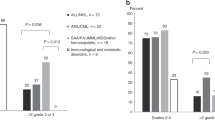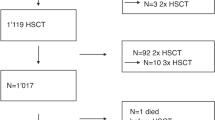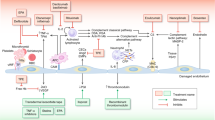Abstract
Early complications can be defined as those occurring within 100 days after transplant. Both epithelial and endothelial damage represent the pathogenetic basis for the onset of the most frequent complications. Clinical features related to endothelial damage depend on the involved district or on the grade and type of general distribution. Veno-occlusive disease (VOD) most often occurs within the first 20 days of haematopoietic SCT (HSCT) and is characterized by the obstruction of small intrahepatic venules and is caused by an initial injury of the sinusoid endothelial cells. The incidence in children ranges between 27 and 40%, and symptoms include hepatomegaly, portal hypertension and ascites. Early intervention with defibrotide (DF) proved to be effective for the treatment; however, overall mortality ranges between 20 and 50%. Thrombotic microangiopathy (TAM) incidence is 4–13%. It is often associated with the use of CYA or tacrolimus, and symptoms include haemolytic anaemia, thrombocytopenia and renal and/or central nervous system impairment. Treatment includes plasmapheresis and supportive care. The promising role of DF needs to be confirmed. The onset of engraftment syndrome may occur 1 or 2 days before the neutrophil count in peripheral blood increases. Clinical symptoms include fever not related to infection, respiratory involvement with pulmonary infiltrates or hypoxia and skin rash. Treatment consists of steroid administration for a few days. Haemorrhagic cystitis (HC) may occur early or later following transplant. Early-onset HC is related to mucosal damage caused by the catabolites of chemotherapy drugs, and late-onset HC is mostly caused by viral infections. The incidence ranges between 1 and 25%. Clinical symptoms include haematuria and dysuria without infections. Treatment includes hyperhydration and platelet support. In case of vescical clots, bladder irrigation is indicated. In advanced cases, hyperbaric oxygen administration or surgery may be useful. The use of cidofovir for BK virus-related HC seems encouraging, but further studies are needed to confirm its real efficacy.
This is a preview of subscription content, access via your institution
Access options
Subscribe to this journal
Receive 12 print issues and online access
$259.00 per year
only $21.58 per issue
Buy this article
- Purchase on Springer Link
- Instant access to full article PDF
Prices may be subject to local taxes which are calculated during checkout
Similar content being viewed by others
References
Shulman HM, Fisher LB, Schoch HG, Henne KW, McDonald GB . Veno-occlusive disease of the liver after marrow transplantation: histological correlates of clinical signs and symptoms. Hepatology 1994; 19: 1171–1181.
Vassal G, Koscielny S, Challine D, Valteau-Couanet D, Boland I, Deroussent A et al. Busulfan disposition and hepatic veno-occlusive disease in children undergoing bone marrow transplantation. Cancer Chemother Pharmacol 1996; 37: 247–253.
Hasegawa S, Horibe K, Kawabe T, Kato K, Kojima S, Matsuyama T et al. Veno-occlusive disease of the liver after allogeneic bone marrow transplantation in children with hematologic malignancies: incidence, onset time and risk factors. Bone Marrow Transplant 1998; 22: 1191–1197.
Carreras E, Bertz H, Arcese W, Vernant JP, Tomas JF, Hagglund H et al. Incidence and outcome of hepatic veno-occlusive disease after blood or marrow transplantation: a prospective cohort study of the European Group for Blood and Marrow Transplantation. European Group for Blood and Marrow Transplantation Chronic Leukemia Working Party. Blood 1998; 92: 3599–3604.
Lee JL, Gooley T, Bensinger W, Schiffman K, McDonald GB . Veno-occlusive disease of the liver after busulfan, melphalan, and thiotepa conditioning therapy: incidence, risk factors, and outcome. Biol Marrow Transplant 1999; 5: 306–315.
Stadtmauer EA, Larson RA, Sievers E, Estey E, Lowenberg B, Leopold LH et al. Analysis of predisposing factors for hepatic veno-occlusive disease after treatment with gemtuzumab ozagamicin (Mylotarg, CMA-676). Blood 2001; 98: 124A.
DeLeve LD, Shulman HM, Mc Donald GB . Toxic injury to hepatic sinusoid: Sinusoidal obstruction syndrome (veno-occlusive disease). Semin Liver Dis 2002; 22: 27–42.
Salat C, Holler E, Kolb HJ, Pihusch R, Reinhardt B, Penovici M et al. The relevance of plasminogen activator inhibitor 1 (PAI-1) as a marker for the diagnosis of hepatic veno-occlusive disease in patients after bone marrow transplantation. Leuk Lymphoma 1999; 33: 25–32.
Rio B, Bauduer F, Arrago JP, Zittoun R . N-terminal peptide of type III procollagen: a marker for the development of hepatic veno-occlusive disease after BMT and a basis for determining the timing of prophylactic heparin. Bone Marrow Transplant 1993; 11: 471–472.
Eltumi M, Trivedi P, Hobbs JR, Portmann B, Cheeseman P, Downie C et al. Monitoring of veno-occlusive disease after bone marrow transplantation by serum aminopropeptide of type III procollagen. Lancet 1993; 342: 518–521.
Heikinheimo M, Halila R, Fasth A . Serum procollagen type III is an early and sensitive marker for veno- occlusive disease of the liver in children undergoing bone marrow transplantation. Blood 1994; 83: 3036–3040.
Chopra R, Eaton JD, Grassi A, Potter M, Shaw B, Salat C et al. Defibrotide for the treatment of hepatic veno-occlusive disease: results of the European compassionate-use study. Br J Haematol 2000; 111: 1122–1129.
Ruutu T, Barosi G, Benjamin RJ, Clark RE, George JN, Gratwohl A, et al., European Group for Blood and Marrow Transplantation; European LeukemiaNet. Diagnostic criteria for hematopoietic stem cell transplant-associated microangiopathy: results of a consensus process by an International Working Group. Haematologica 2007; 92: 95–100.
Daly AS, Xenocostas A, Lipton JH . Transplantation-associated thrombotic microangiopathy: twenty-two years later. Bone Marrow Transplant 2002; 30: 709–715. Review.
Zeigler ZR, Shadduck RK, Nemunaitis J, Andrews DF, Rosenfeld CS . Bone marrow transplant-associated thrombotic microangiopathy: a case series. Bone Marrow Transplant 1995; 15: 247–253.
Uderzo C, Bonanomi S, Busca A, Renoldi M, Ferrari P, Iacobelli M et al. Risk factors and severe outcome in Thrombotic Microangiopathy after Allogeneic Hematopoietic Stem Cell Transplantation. Transplantation 2006; 82: 638–644.
Spitzer TR . Engraftment syndrome following haematopoietic stem cell transplantation. Bone Marrow Transplant 2001; 27: 893–898.
Gorczynska E, Turkiewicz D, Rybka K, Toporski J, Kalwak K, Dyla A et al. Incidence, clinical outcome, and management of virus-induced hemorrhagic cystitis in children and adolescents after allogeneic hematopoietic cell transplantation. Biol Blood Marrow Transplant 2005; 11: 797–804.
Cesaro S, Brugiolo A, Faraci M, Uderzo C, Rondelli R, Favre C et al. Incidence and treatment of hemorrhagic cystitis in children given hematopoietic stem cell transplantation: a survey from the Italian association of pediatric hematology oncology-bone marrow transplantation group. Bone Marrow Transplant 2003; 32: 925–931.
Hale GA, Rochester RJ, Heslop HE, Krance RA, Gingrich JR, Benaim E et al. Hemorrhagic cystitis after allogeneic bone marrow transplantation in children: clinical characteristics and outcome. Biol Blood Marrow Transplant 2003; 9: 698–705.
Leung AY, Suen CK, Lie AK, Liang RH, Yuen KY, Kwong YL . Quantification of polyoma BK viruria in hemorrhagic cystitis complicating bone marrow transplantation. Blood 2001; 98: 1971–1978.
Droller MJ, Saral R, Santos G . Prevention of cyclophosphamide-induced hemorragic cystitis. Urology 1982; 20: 256–258.
Author information
Authors and Affiliations
Consortia
Corresponding author
Additional information
Conflict of interest
None of the authors declared any financial interests.
Rights and permissions
About this article
Cite this article
Miano, M., Faraci, M., Dini, G. et al. Early complications following haematopoietic SCT in children. Bone Marrow Transplant 41 (Suppl 2), S39–S42 (2008). https://doi.org/10.1038/bmt.2008.53
Published:
Issue Date:
DOI: https://doi.org/10.1038/bmt.2008.53
Keywords
This article is cited by
-
Incidence of acute kidney injury after hematopoietic stem cell transplantation in children: a systematic review and meta-analysis
European Journal of Pediatrics (2023)
-
Low incidence of hemorrhagic cystitis following ex vivo T-cell depleted haploidentical hematopoietic cell transplantation in children
Bone Marrow Transplantation (2020)
-
Effects of partly supervised and home-based exercise program in patients undergoing hematopoietic stem cell transplantation: a case-control study
Supportive Care in Cancer (2020)
-
Validation of treatment outcomes according to revised severity criteria from European Society for Blood and Marrow Transplantation (EBMT) for sinusoidal obstruction syndrome/veno-occlusive disease (SOS/VOD)
Bone Marrow Transplantation (2019)
-
Imaging of acute and subacute toxicities of cancer therapy in children
Pediatric Radiology (2016)



